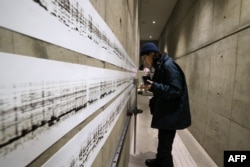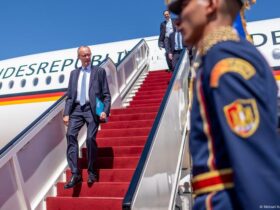In a century -old building in Tehran, Saeed Anvarnezad changed the dial of a vintage radio to tune the first recorded sounds of Iran, serving some earthquake changes that were serving as a reminder of the country’s history Used to give shape.
Along with the team of fellow enthusiasts, he spent months to monitor the initial recording of Iranian music, speeches, interviews, dramatic plays, radio broadcasting and even a century of daily life to the present day. .
“Sound is a phenomenon to which we pay little attention … although it is very important, one of the organizers of the” Soundscape “exhibition, Anvarnezad said.
And “EA’s era of early sound recording in Iran is a very important time in the socio-political history of the country.”
He highlighted the emotional power of early voice recording, stating that he “in a very raw and pure way … the feeling in that moment has captured that time,” contrary to the written record.
For Adarinejad, the oldest living sound recording from Iran till 1898 and 1899, during the reign of Mojafar Al-Din Shah of the Kajar dynasty, which had come across the country in the country since the beginning of the 20th century.
His rule revealed the constitutional revolution, an important moment in Iran’s political change that established a Parliament and the constitutional monarchy.
“It was a time when … a new order was taking shape in Iranian mind and very imported things were happening political, social and culturally,” he said.
“We thought it would be good to have a new approach to the sound (from that time) and attach the audience with it.”
On tuning wooden frame antique radio, a chilling broadcast announced the uprooting of Prime Minister Mohammad Mosadegh in 1953, who pushed the United States and Britain moving towards a coup for the nationalization of Iran oil industry. Was.
“This is Tehran! Good news! Good news! People from Iran cities be awake and cautious, the traitor Mosadegh has run away!” Crack the voice of a radio anchor.
‘Mysterious void’
Iran’s first recorded call in Record to Prayer in Ether 1912 or 1913, and 1959 reports on the death of the first female singer to publicly perform in the country.
A striking installation in the exhibition included a mechanical device on a concrete wall with gear, chains, wheels and a liver, which played chronic recordings of string tar instrument through retro handsets.
Another, Mowj Negger, depicted the printed sound waves arranged in three rows on a wall, with a metal device that had gone with waves.
When transferred, the device kajar and early wrestlers (1925–79) activate the tune from ages that once echoed through the grand palaces of Iran and the streets of the city.
Nearby stood in a wooden cabinet called “The Silent Closet”, which displays a series of photographs from the First World War -but without sound together.
Anbak Axon, the organizer of another exhibition, said, “There is no sound recording from Iran during this period, not because the technology was unavailable, but there is a possibility that the recording sound was not a priority.”
“There was a 12 -year silence which remains a mysterious void in Iran’s hearing history.”
For centuries, Sound has played a central role in Persian culture, located with poetry and identity.
For 21-year-old Sarwin Faizian, visiting the exhibition with friends was a depth experience “as I was experiencing my parents’ past.”
Similarly, Falmeh Sadgi felt more than Nostalgia, while 63 -year -old Kamran Asadi found the exhibition unexpectedly individual.
“This is a very nice and intimate atmosphere for me,” Hey said, working on an old song in the background.
“It is good for the younger generation to learn where Iran’s legacy of music and art came from.”







Leave a Reply